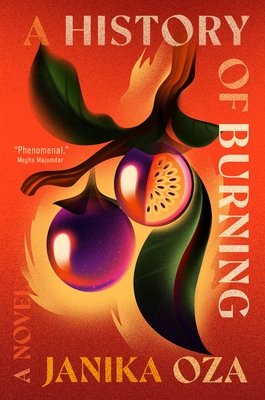A History of Burning by Janika Oza
Review of A History of Burning by Janika Oza
A History of Burning by Janika Oza (2023). Published by Grand Central Publishing.
Ever since I watched the movie Mississippi Masala for the first time, inviting me into the world of Mira Nair and her cinematic legacy, I have been wanting to learn more about the South Asian diaspora and forced migration in and out of Africa.
I never knew about what happened in Uganda before that movie, and suddenly it was like a whole new world was unlocked.
I was actually wandering my library in search of something new to read when I stumbled into the new fiction section and found this book.
It was the title on the spine that drew me into the book originally, and when I read the synopsis, I knew I had to keep this one.
There are few books that have me up all night to finish reading them. One was Brotherless Night, which I now think is one of my favorite novels I have ever read, and another was The Girl Who Fell Beneath the Sea. This book inspired me to stay up and read all of it—I was so invested in it.
I’m already revealing too much! Let’s get into the review.
The story of one South Asian family in Uganda and their eventual expulsion from their land.
This is a story about one family, but told through multiple generations.
We begin with Pirbhai, who lived in rural India. He is taken away from his home and family after searching for work, and finds himself employed by the British and taken away to East Africa, specifically Uganda. He was tricked, as he did not know enough English to understand the contract he was signing.
There, with many other Indian workers, he toils at the railroads for the equivalent of something to send home to his family. It’s not much, especially with the conditions they’re forced to work under.
However, Pirbhai is going to make one big betrayal against his fellow countrymen to ensure his survival and money in this new land. The title takes itself literally here, as Pirbhai’s actions are going to cast a major shadow of the family history, especially as things start ramping up.
Eventually, Pirbhai marries a girl from back home, who is brought to Africa. She must learn to adjust to the climate and the new world around her, and they start a family. They work their ways up in this society, and earn respect.
Their children are allowed the opportunity to get an education, and see themselves as African. One granddaughter, when she is older, even becomes involved with political movements, which eventually comes to bite her when Ugandan nationalism rears its head.
Even after Pirbhai and his wife have passed away, Idi Amin takes control of Uganda, and the family is forced to make a decision about what to do next. As the South Asians are ordered to be expelled, they might have to leave everything behind.
This is where the family unit really fractures in the novel, and there is no going back. Multigenerational tales are something that are really hard to pull off in literature, and sometimes they get really long (i.e. in the vein of a novel like Pachinko).
I thought this one was so well written, and I was highly invested in the story, even when it began to take place fifty years after the events of the original storyline with Pirbhai. It really shows ripple effects, especially when the family begins to fall apart with time.
Overall Thoughts
I’m so glad I randomly stumbled upon this book in the library. It has become one of my new favorites, and I think I will be purchasing a copy of it for my personal collection.
I also really liked Oza’s writing, and will keep an eye out in the future for her work. I was so surprised to see this was an early effort in her career, yet the style of writing is so rich and accessible. It truly had an eye for craft.
Go pick this one up if you haven’t already—if you’re interested, you probably will not regret it.
Follow me below on Instagram and Goodreads for more.


![Jeju-do (제주도) is one of those places that reminds you of how stunning the world is
[7.12.2024 부터 7.14.2024 까지]](https://images.squarespace-cdn.com/content/v1/5ea1f794501b7153b29e7cd7/1721033601522-554E76HR01JUHDWZBJ1I/image-asset.jpeg)








